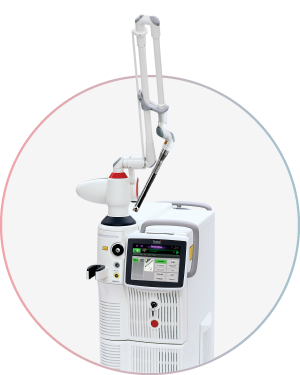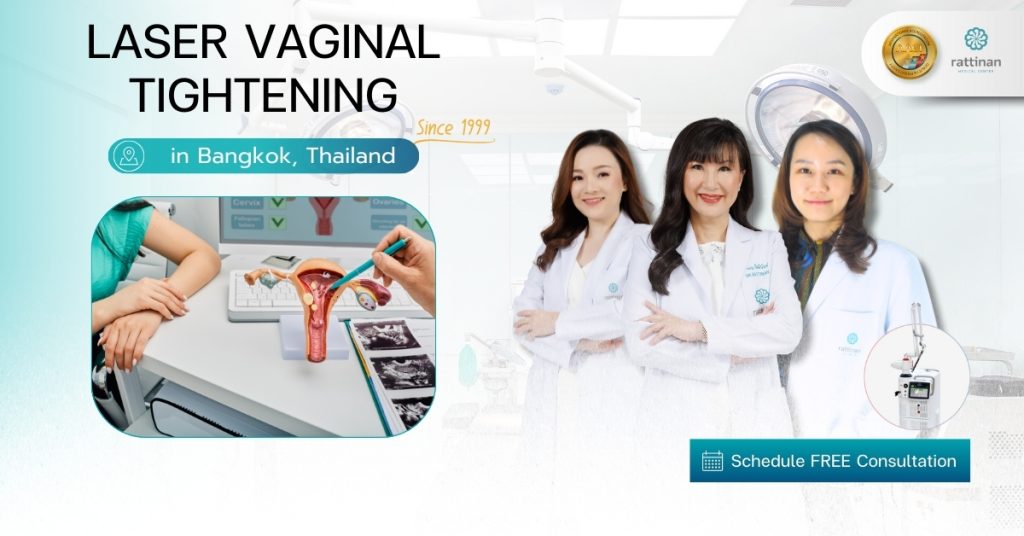Looking for non-surgical solutions to improve vaginal tightness, moisture, and comfort? Laser vaginal tightening is a safe, effective option now available in Bangkok.
Rattinan Medical Center’s Virgin Lift treatment uses advanced FotonaSmooth laser technology to rejuvenate and restore vaginal tissue, addressing issues such as mild urinary incontinence, vaginal laxity, and dryness.
The FotonaSmooth laser stimulates collagen and elastin production, revitalizing the vaginal muscles for improved elasticity and a smoother, more youthful feel. This non-invasive approach makes it ideal for women who want to enhance pelvic muscle tone and vaginal health without the downtime of surgery.
What Is Virgin Lift Laser Vaginal Tightening?
Virgin Lift is a specialized laser vaginal tightening treatment that uses FotonaSmooth technology to target the vaginal and pelvic muscles, offering a gentle yet effective boost in elasticity and strength. Unlike traditional surgery, this treatment does not require incisions or recovery time, making it a comfortable choice for women experiencing mild incontinence, vaginal looseness, or reduced natural moisture.

How Does FotonaSmooth Technology Work?
FotonaSmooth’s advanced laser system uses a Smart Scanner to deliver laser energy precisely to deeper layers of vaginal tissue. This controlled energy promotes collagen and elastin production, providing natural improvements in elasticity and hydration. Additionally, the laser increases blood flow to the pelvic tissue, strengthening the vaginal walls and enhancing daily comfort.
Benefits of Virgin Lift Laser Vaginal Tightening
Virgin Lift laser vaginal tightening offers several health and cosmetic benefits, including:
- Enhanced Vaginal Tightness Naturally
The FotonaSmooth laser stimulates collagen and elastin production, rejuvenating the vaginal walls and tightening the area naturally—without the need for surgical incisions. - Reduction in Mild Urinary Incontinence
Strengthening the pelvic floor muscles can reduce mild urinary incontinence. Virgin Lift improves the structural support of the pelvic muscles, providing better control during activities like exercise or coughing. - Improved Moisture and Comfort
FotonaSmooth technology enhances blood flow, which promotes natural moisture and reduces dryness, increasing comfort during intimate activities and daily life. - Non-Invasive and No Downtime Required
Since Virgin Lift is non-surgical, it requires no incisions or recovery time. Women can resume normal activities immediately after treatment. - Gentle Rejuvenation for Women of All Ages
Virgin Lift gently strengthens vaginal tissues, restoring youthful tone and firmness, making it suitable for women of all ages, from post-childbirth to menopause.
Why Choose Rattinan Medical Center for Laser Vaginal Tightening?
Rattinan Medical Center offers expert medical care for laser vaginal tightening in Bangkok, using the latest FotonaSmooth laser technology. The clinic’s experienced team is dedicated to providing high-quality, personalized care in a comfortable and hygienic environment.
- Professional Care by Specialists
Our team of skilled dermatology and gynecology professionals ensures safe, precise, and effective treatment. - Personalized Virgin Lift Program Options
Rattinan Medical Center’s Virgin Lift program offers tailored options to meet specific needs, from addressing incontinence to enhancing moisture and elasticity. The following programs are designed to provide the best outcomes based on individual health concerns:
IncontiLase
This program is perfect for addressing mild urinary incontinence. The laser strengthens the tissue around the bladder, providing better control and comfort during daily activities.
IncontiLase
For women seeking additional firmness, IntimaLase boosts collagen and elastin in the pelvic area, restoring flexibility and improving overall vaginal health.
RenovaLase
For women experiencing dryness or discomfort due to hormonal changes, RenovaLase offers hydration and restoration, creating a healthier, more comfortable vaginal environment.
How the FotonaSmooth Laser Works with Virgin Lift
Virgin Lift uses FotonaSmooth laser technology, a well-researched approach to restoring vaginal and pelvic health without causing irritation or damage. Here’s how it works:
- Laser Energy Penetration
The FotonaSmooth laser releases a long-pulse energy wavelength that reaches deep layers of the tissue, triggering collagen and elastin synthesis without harming the surrounding areas. - Collagen and Elastin Stimulation
This laser technology encourages collagen and elastin production, which naturally strengthens the tissue for improved tightness and elasticity. - Enhanced Blood Circulation
By increasing blood flow, the laser enhances the delivery of nutrients to the tissues, resulting in natural hydration and comfort in the pelvic area. - Comfortable, No-Downtime Recovery
Virgin Lift requires no incisions, anesthesia, or downtime, allowing patients to return to their regular routine immediately after treatment.
The Virgin Lift Procedure – What to Expect
Virgin Lift treatments are designed to be convenient and effective. Here’s what patients can expect when undergoing laser vaginal tightening at Rattinan Medical Center:
- Consultation and Preparation
Every Virgin Lift treatment starts with a consultation to assess individual needs and confirm that laser vaginal tightening is the best option. - FotonaSmooth Laser Application
The treatment typically takes 15–30 minutes, during which FotonaSmooth laser energy is applied to the targeted area. The laser stimulates tissue repair and collagen production while remaining gentle on the surrounding tissues. - Post-Treatment Care and Recovery
Since there is no downtime, patients can return to their regular activities immediately after the session. Avoid intense exercise, swimming, or sexual activity for about a week to allow the tissues to heal fully.
Who Can Benefit from Virgin Lift?
Virgin Lift is recommended for women seeking non-surgical solutions for vaginal and pelvic issues, such as:
- Post-Childbirth Rejuvenation
Virgin Lift is ideal for mothers seeking to restore firmness and elasticity to the vaginal area post-delivery, enhancing comfort and confidence. - Women Experiencing Mild Urinary Incontinence
If you have mild urinary incontinence triggered by actions like coughing or exercise, Virgin Lift can strengthen pelvic muscles, offering better control. - Women Seeking Increased Vaginal Moisture
Women experiencing dryness or irritation, particularly during menopause, can benefit from the increased moisture and tissue health provided by Virgin Lift. - Those with Reduced Vaginal Firmness
Virgin Lift helps tighten tissues, improving firmness and elasticity for women who feel they’ve lost natural tightness over time.
Frequently Asked Questions About Laser Vaginal Tightening
1. Is Virgin Lift painful?
Virgin Lift is a comfortable procedure, and most patients describe the sensation as mild warmth. No incisions are made, and there is no recovery period.
2. How long do results from Virgin Lift last?
Results are long-lasting and improve with each treatment. For optimal outcomes, Rattinan Medical Center recommends a series of three treatments spaced a month apart, followed by an annual maintenance session.
3. Are there any side effects to laser vaginal tightening?
Since Virgin Lift is non-invasive, side effects are minimal. Some patients may experience slight warmth or sensitivity, which typically fades within a day.
4. Can Virgin Lift help with incontinence?
Yes, Virgin Lift strengthens the pelvic floor and bladder-supporting tissues, effectively reducing mild urinary incontinence for many women.
5. How soon can I resume daily activities after treatment?
You can return to normal activities immediately, although avoiding strenuous exercise, swimming, or sexual activity for 7 days is recommended for optimal recovery.
6. Is Virgin Lift safe?
Yes, Virgin Lift uses FotonaSmooth technology, a well-researched and globally recognized laser system that is safe for sensitive tissues and has been approved by health authorities worldwide.
Our Doctors

Dr. Rattinan Treeratana
M.D. – Founder & Managing Director

Dr. Naruemon Wichean
M.D.

Dr. Jutamas Tankunakorn
Dermatologist
Discover safe, comfortable laser vaginal tightening in Bangkok with Rattinan Medical Center’s Virgin Lift treatment. Combining cutting-edge FotonaSmooth laser technology with personalized care, Virgin Lift provides a natural, non-surgical option for rejuvenation and comfort. With proven results and a supportive team of professionals, Virgin Lift helps women enhance their quality of life with confidence.



Dr. Suthipong Treeratana (Dr. Nueng) specializes in liposuction and body contouring surgery, focusing on personalized treatment plans to help you feel more confident in yourself.